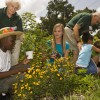 Several economic factors should be considered in selecting an agricultural irrigation system. This 7-page fact sheet compares two widely used irrigation systems for tomato production: seepage and sub-surface drip irrigation. Written by Jenna Rogers, Tatiana Borisova, Jeffrey Ullman, Kelly Morgan, Lincoln Zotarelli, and Kelly Grogan, and published by the UF Department of Food and Resource Economics, October 2014. (UF/IFAS Photo: Tyler Jones)
Several economic factors should be considered in selecting an agricultural irrigation system. This 7-page fact sheet compares two widely used irrigation systems for tomato production: seepage and sub-surface drip irrigation. Written by Jenna Rogers, Tatiana Borisova, Jeffrey Ullman, Kelly Morgan, Lincoln Zotarelli, and Kelly Grogan, and published by the UF Department of Food and Resource Economics, October 2014. (UF/IFAS Photo: Tyler Jones)
http://edis.ifas.ufl.edu/fe960
Tag: Tatiana Borisova
Florida Strawberry Producers' Experiences with Anthracose and Botrytis Fruit Rot, and Producers' Use of the Strawberry Advisory System
 Florida’s producers use fungicides to manage anthracnose and botrytis fruit rot diseases, which find favorable growth conditions in Florida’s climate and can reduce strawberry yields and profits. The Strawberry Advisory System (SAS) uses information about weather conditions and user-entered information about past fungicide applications to evaluate the potential spread of these diseases in strawberry fields. If the risk of disease spread is low, no fungicide application is recommended, allowing producers to save on fungicide application costs. In this study, we summarize the results of a 2012/2013 survey of strawberry producers, and focus on the questions, How significant is the impact of anthracnose and botrytis on Florida strawberry producers’ yields? What are the typical fungicide application frequencies used by the producers? What percent of strawberry producers use SAS? and Are there any effects of SAS subscription on producers’ fungicide application? This 4-page fact sheet was written by Tatiana Borisova, Zhengfei Guan, Ekaterina Vorotnikova, Natalia Peres, and John VanSickle, and published by the UF Department of Food and Resource Economics, October 2014.
Florida’s producers use fungicides to manage anthracnose and botrytis fruit rot diseases, which find favorable growth conditions in Florida’s climate and can reduce strawberry yields and profits. The Strawberry Advisory System (SAS) uses information about weather conditions and user-entered information about past fungicide applications to evaluate the potential spread of these diseases in strawberry fields. If the risk of disease spread is low, no fungicide application is recommended, allowing producers to save on fungicide application costs. In this study, we summarize the results of a 2012/2013 survey of strawberry producers, and focus on the questions, How significant is the impact of anthracnose and botrytis on Florida strawberry producers’ yields? What are the typical fungicide application frequencies used by the producers? What percent of strawberry producers use SAS? and Are there any effects of SAS subscription on producers’ fungicide application? This 4-page fact sheet was written by Tatiana Borisova, Zhengfei Guan, Ekaterina Vorotnikova, Natalia Peres, and John VanSickle, and published by the UF Department of Food and Resource Economics, October 2014.
http://edis.ifas.ufl.edu/fe957
Costs and Benefits of More Efficient Irrigation Systems for Florida Chipping Potato Production
 The goal of this 11-page fact sheet is to help producers and other interested parties understand how alternative irrigation systems can affect economic outcomes in agricultural operations. We used chipping potato production in the Hastings area in northeast Florida as an example to discuss factors to consider when selecting an irrigation system. Written by Jenna Rogers, Tatiana Borisova, Lincoln Zotarelli, Kelly Grogan, Jeffrey Ullman, Jessica Bertine, and Kelly Morgan, and published by the UF Department of Food and Resource Economics, September 2014.
The goal of this 11-page fact sheet is to help producers and other interested parties understand how alternative irrigation systems can affect economic outcomes in agricultural operations. We used chipping potato production in the Hastings area in northeast Florida as an example to discuss factors to consider when selecting an irrigation system. Written by Jenna Rogers, Tatiana Borisova, Lincoln Zotarelli, Kelly Grogan, Jeffrey Ullman, Jessica Bertine, and Kelly Morgan, and published by the UF Department of Food and Resource Economics, September 2014.
http://edis.ifas.ufl.edu/fe953
Water Withdrawals and Their Use in Florida in 2010
 This publication is based on Florida water use information collected by the United States Geological Service. It expands on EDIS document FE797 that examined Florida water withdrawals data for 2005. In addition, in EDIS document FE757 (Florida’s Water Resources), the authors describe Florida’s abundant water resources—the state receives about 54 inches of rainfall per annum, compared to 30 inches nationwide, and it overlies prolific aquifers. Whether water is scarce or abundant, however, depends not only upon available supplies, but also upon patterns of water use. To gather this information, the United States Geological Survey employs several water-use categories to develop estimates of water withdrawals and water use. This 5-page fact sheet was written by Tatiana Borisova and Jenna Rogers, and published by the UF Department of Food and Resource Economics, May 2014.
This publication is based on Florida water use information collected by the United States Geological Service. It expands on EDIS document FE797 that examined Florida water withdrawals data for 2005. In addition, in EDIS document FE757 (Florida’s Water Resources), the authors describe Florida’s abundant water resources—the state receives about 54 inches of rainfall per annum, compared to 30 inches nationwide, and it overlies prolific aquifers. Whether water is scarce or abundant, however, depends not only upon available supplies, but also upon patterns of water use. To gather this information, the United States Geological Survey employs several water-use categories to develop estimates of water withdrawals and water use. This 5-page fact sheet was written by Tatiana Borisova and Jenna Rogers, and published by the UF Department of Food and Resource Economics, May 2014.
http://edis.ifas.ufl.edu/fe943
Socio-Demographic Characteristics and Concerns about Water Quality Issues of Master Gardener Program Volunteers
 To respond to residents’ informational needs, the Cooperative Extension Service offers a variety of volunteer training and certification programs. Who participates in such programs? What types of audiences are being reached? Do such programs increase knowledge and change behavior of the volunteers? In this article, we attempt to answer these questions by summarizing existing studies and using responses to a regional public survey, and by focusing on the Master Gardener program and surface water quality issues as examples. This 7-page fact sheet was written by Tatiana Borisova, Michael Smolen, Maria Pilar Useche, Jon Calabria, Nickola Sochacka, Damian Adams, Diane Boellstorff, Jason Evans, and Robert Mahler, and published by the UF Department of Food and Resource Economics, May 2014.
To respond to residents’ informational needs, the Cooperative Extension Service offers a variety of volunteer training and certification programs. Who participates in such programs? What types of audiences are being reached? Do such programs increase knowledge and change behavior of the volunteers? In this article, we attempt to answer these questions by summarizing existing studies and using responses to a regional public survey, and by focusing on the Master Gardener program and surface water quality issues as examples. This 7-page fact sheet was written by Tatiana Borisova, Michael Smolen, Maria Pilar Useche, Jon Calabria, Nickola Sochacka, Damian Adams, Diane Boellstorff, Jason Evans, and Robert Mahler, and published by the UF Department of Food and Resource Economics, May 2014.
http://edis.ifas.ufl.edu/fe942
Valuing the Ecosystem Services of Florida‹s Forest Conservation Programs: The Economic Benefits of Protecting Water Quality (FOR309/FR377)
 How much are Floridians willing to pay for water quality protection programs that include forest conservation? This 9-page fact sheet reports the results of a study to answer this question, using a benefit transfer approach. Written by Melissa M. Kreye, Francisco J. Escobedo, Damian C. Adams, Taylor Stein, and Tatiana Borisova, and published by the UF Department of School of Forest Resources and Conservation, April 2013.
How much are Floridians willing to pay for water quality protection programs that include forest conservation? This 9-page fact sheet reports the results of a study to answer this question, using a benefit transfer approach. Written by Melissa M. Kreye, Francisco J. Escobedo, Damian C. Adams, Taylor Stein, and Tatiana Borisova, and published by the UF Department of School of Forest Resources and Conservation, April 2013.
http://edis.ifas.ufl.edu/fr377
Public Opinion about Water Availability (FE845)
 This 8-page fact sheet summarizes results of a public survey about Florida water resources. The respondents were asked about the quantity of water in their area, water availability in ten years, the likelihood of prolonged drought, and the effect of climate change on rainfall. Written by Tatiana Borisova and Damian Adams, and published by the UF Department of Food and Resource Economics, March 2012.
This 8-page fact sheet summarizes results of a public survey about Florida water resources. The respondents were asked about the quantity of water in their area, water availability in ten years, the likelihood of prolonged drought, and the effect of climate change on rainfall. Written by Tatiana Borisova and Damian Adams, and published by the UF Department of Food and Resource Economics, March 2012.
http://edis.ifas.ufl.edu/fe845
Quick Overview of Extension Programs to Educate Homeowners about Environmentally Friendly Landscape Practices in Florida, South Carolina, and Tennessee (FE892)
 Nationwide, landscape irrigation accounts for more than 7 billion gallons of water per day. But up to 50 percent of this water is wasted due to overwatering, poor irrigation system design, evaporation, or other factors. Additionally, excessive or poorly timed fertilizer application can cause pollution runoff and deterioration of surface and ground water. This 8-page fact sheet presents a quick overview of the Yards and Neighborhoods program that educates homeowners about nine core principles for landscape management. Written by Tatiana Borisova, Katie Giacalone, Ruth Anne Hanahan, and Esen Momol, and published by the UF Department of Food and Resource Economics, August 2011. (UF/IFAS Photo Thomas Wright)
Nationwide, landscape irrigation accounts for more than 7 billion gallons of water per day. But up to 50 percent of this water is wasted due to overwatering, poor irrigation system design, evaporation, or other factors. Additionally, excessive or poorly timed fertilizer application can cause pollution runoff and deterioration of surface and ground water. This 8-page fact sheet presents a quick overview of the Yards and Neighborhoods program that educates homeowners about nine core principles for landscape management. Written by Tatiana Borisova, Katie Giacalone, Ruth Anne Hanahan, and Esen Momol, and published by the UF Department of Food and Resource Economics, August 2011. (UF/IFAS Photo Thomas Wright)
http://edis.ifas.ufl.edu/fe892
A Guide to EPA’s Numeric Nutrient Water Quality Criteria for Florida (SL316/SS528)
This revised 10-page guide provides a basic, concise, and understandable description of the United States Environmental Protection Agency’s (EPA) numeric nutrient criteria for Florida, the background events that led to its release, some pertinent scientific issues, and implications for the future. Written by Thomas Obreza, Mark Clark, Brian Boman, Tatiana Borisova, Matt Cohen, Michael Dukes, Tom Frazer, Ed Hanlon, Karl Havens, Chris Martinez, Kati Migliaccio, Sanjay Shukla, and Alan Wright, and published by the UF Department of Soil and Water Science, March 2011.
http://edis.ifas.ufl.edu/ss528
FE843 Public Opinion about Drinking Water Issues in Florida
FE843, a 10-page illustrated report by Tatiana Borisova, John Brett, and Cassel Gardner, summarizes the results of a public survey about the drinking water issues in Florida. Published by the UF Department of Food and Resource Economics, October 2010.
http://edis.ifas.ufl.edu/fe843
FE844 Public Opinion about Surface Water and Groundwater Quality in Florida
FE844, a 6-page illustrated report by Tatiana Borisova, John Brett, and Cassel Gardner, summarizes the results of a public survey about the quality of surface water and groundwater resources in Florida. Published by the UF Department of Food and Resource Economics, October 2010.
http://edis.ifas.ufl.edu/fe844
FE842 Public Opinion about Actions to Protect Water Resources
FE842, a 9-page illustrated report by Tatiana Borisova, John Brett, and Cassel Gardner, summarizes the results of a public survey about the protected water resources in Florida. Published by the UF Department of Food and Resource Economics, October 2010.
http://edis.ifas.ufl.edu/fe842
FE841 Public Attitudes about Water Issues in Florida
FE841, a 7-page illustrated report by Tatiana Borisova, John Brett, and Cassel Gardner, summarizes the results of a public survey about importance of water-resource issues in Florida. Published by the UF Department of Food and Resource Economics, October 2010.
http://edis.ifas.ufl.edu/fe841
FE851 Use, Perceptions, and Barriers to Water Conservation Strategies for Florida Water Utilities
FE851, an 18-page illustrated report by Shirish Rajbhanary, Tatiana Borisova, Damian Adams, Dwayne Haynes, and Chris Boyer, presents the results of a 2009–2010 survey of representatives of Florida’s drinking water systems to examine the relative use of conservation strategies by Florida water utilities. Includes references. Published by the UF Department of Food and Resource Economics, September 2010.
http://edis.ifas.ufl.edu/fe851
FE826 Balancing Agricultural Production and Environmental Protection in the Tri-County Agricultural Area: Results from Stakeholder Discussions
FE826, a 6-page illustrated fact sheet by Tatiana Borisova, Laila Racevskis, Bryan Fluech, and Jane Provancha, summarizes key points from discussions with various stakeholders in the Putnam, St. Johns, and Flagler tri-county agricultural area during a session of the Florida Natural Resources Leadership Institute held in May of 2008. The discussions focused on the issues of balancing agricultural production and environmental protection in the region. Includes references. Published by the UF Department of Food and Resource Economics, December 2009.
http://edis.ifas.ufl.edu/fe826
SL316/SS528 A Guide to EPA’s Proposed Numeric Nutrient Water Quality Criteria for Florida
SL316, a 9-page illustrated guide by Thomas Obreza, Mark Clark, Brian Boman, Tatiana Borisova, Matt Cohen, Michael Dukes, Tom Frazer, Ed Hanlon, Karl Havens, Chris Martinez, Kati Migliaccio, Sanjay Shukla, and Alan Wright, provides a basic, concise, and understandable description of the United States Environmental Protection Agency’s (EPA) proposed numeric nutrient criteria for Florida, the background events that led to its release, some pertinent scientific issues, and implications for the future. Published by the UF Department of Soil and Water Science, February 2010.
http://edis.ifas.ufl.edu/ss528
FE824 Water Quality Credit Trading: General Principles
FE824, an 8-page fact sheet by Tatiana Borisova and Fritz Roka, reviews the basic components of a water quality credit trading program and discusses opportunities and challenges associated with a water quality credit trading program design. Includes references. Published by the UF Department of Food and Resource Economics, December 2009.
http://edis.ifas.ufl.edu/fe824
FE811 Balancing Urban Water Demand and Supply in Florida: Overview of Tools Available to Water Managers
FE811, a 10-page fact sheet by Tatiana Borisova, Colin Rawls, and Damian Adams, discusses alternative strategies that can be used by water utility managers to balance water demand and supply in the residential sector. Includes references. Published by the UF Department of Food and Resource Economics, October 2009.
http://edis.ifas.ufl.edu/FE811
FE801 Economic Approach to Valuing Information with Applications to Climate Information
FE801, a 6-page illustrated fact sheet by Tatiana Borisova, Norman Breuer, and Irina Grinberg, gives a basic introduction to the economic approach to valuing information. Specifically, it discusses a way to evaluate the information in Florida climate forecasts in order to improve agriculture decisions and thereby produce more reliable economic outcomes. Includes references. Published by the UF Department of Food and Resource Economics, June 2009.
http://edis.ifas.ufl.edu/FE801
FE799 Public Policy and Water in Florida
FE799, an 8-page illustrated fact sheet by Roy R. Carriker and Tatiana Borisova, describes the state policies and regulations that provide the framework for water resources use and the impact of human activities on water resources in the state of Florida. Includes references. Published by the UF Department of Food and Resource Economics, May 2009.
http://edis.ifas.ufl.edu/FE799